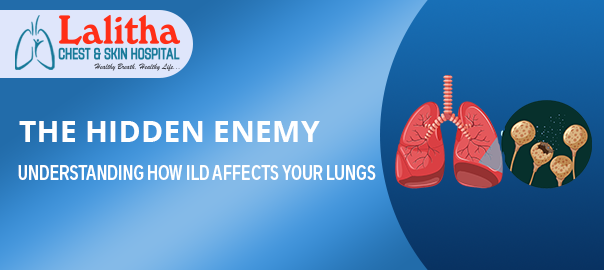Interstitial Lung Disease (ILD) is an umbrella term for a large group of over 200 disorders that cause progressive scarring of the lung tissue over time, interfering with a person’s ability to breathe and get enough oxygen into the bloodstream.
The scarred lung tissue becomes stiff, thickened, and stressed, decreasing lung function. This damage to the lung tissue causes shortness of breath, a dry persistent cough, fatigue, weakness, and chest discomfort.
Interstitial Lung Disease (ILD) & It’s Effect on Lungs:
The term “interstitial” refers to the tissue and space around the air sacs of the lungs called the ‘Interstitium’. The ‘Interstitium’ provides support to the lungs’ microscopic air sacs (alveoli). When affected by ILD, this tissue thickens and becomes scarred, making it difficult for oxygen to pass through the alveoli and into the bloodstream.
From long-term exposure to harmful substances like asbestos, coal dust, and silica, to autoimmune diseases, specific medications, and even unknown causes, ILD has many causes, making it dangerous because it can affect any person.
Raising awareness about this condition is extremely important, especially in Karimnagar, where the incidence tends to be high. So, with inputs from the top chest physician in Karimnagar, Dr. Raj Kumar Korra, we bring you this blog to empower you with the required information about ILD—its causes, diagnosis, and treatment options in Karimnagar. Read on.
Interstitial Lung Disease (ILD) – How ILD Damages Lung Tissue:
- Inflammation: The initial phase of ILD often involves inflammation of the interstitium. This inflammation can be caused by various factors, including environmental pollutants, infections, autoimmune diseases, or unknown reasons (idiopathic).
- Fibrosis: Persistent inflammation leads to fibrosis, where normal lung tissue replaces scar tissue. This scar tissue is thick, stiff, and less elastic compared to healthy lung tissue. The fibrosis process can continue to progress, leading to severe lung impairment.
- Thickened Interstitium: As fibrosis progresses, the interstitium thickens, making it more difficult for oxygen to move from the alveoli into the blood vessels. This thickened barrier disrupts the normal exchange of oxygen and carbon dioxide.
Interstitial Lung Disease (ILD) – The Impact on Oxygen Intake:
The primary function of the lungs is to facilitate the exchange of oxygen and carbon dioxide between the air we breathe and the blood. In a healthy lung, oxygen passes easily through the thin walls of the alveoli and into the bloodstream. However, in ILD, the thickened and scarred interstitium hinders this process in several ways:
- Reduced Oxygen Diffusion: The thickened interstitium slows down the diffusion of oxygen into the blood. This means less oxygen can be transported to the body’s tissues and organs.
- Decreased Lung Compliance: The stiffness caused by fibrosis reduces lung compliance, meaning the lungs are less able to expand and contract. This makes breathing more difficult and less efficient.
- Impaired Gas Exchange: The overall gas exchange efficiency (oxygen in, carbon dioxide out) is compromised. As a result, patients with ILD often experience shortness of breath, especially during physical activity.
Symptoms and Diagnosis:
The symptoms of ILD can vary depending on the type and severity of the disease but often include:
- Persistent dry cough
- Shortness of breath
- Fatigue
- Chest discomfort
- Clubbing of fingers (in advanced cases)
Diagnosing ILD typically involves:
- Medical History and Physical Examination: Doctors will assess symptoms, exposure history (e.g., smoking, occupational hazards), and family history of lung disease.
- Imaging Tests: High-resolution computed tomography (HRCT) scans are crucial for identifying the pattern and extent of lung damage.
- Pulmonary Function Tests: These tests measure lung capacity and the efficiency of gas exchange.
- Biopsy: In some cases, a lung biopsy may be necessary to confirm the diagnosis and identify the specific type of ILD.
Living with ILD:
Living with ILD can be challenging, but there are ways to manage the condition and maintain a good quality of life:
- Regular Medical Follow-Up: Frequent check-ups with a pulmonologist are essential for monitoring disease progression and adjusting treatments as necessary.
- Support Networks: Joining support groups or counseling can provide emotional support and practical advice from others living with ILD.
- Stay Active: Engaging in physical activity within your limits can help maintain lung function and overall health.
- Educate Yourself: Understanding your condition can empower you to make informed decisions about your health and treatment options.
Interstitial lung disease (ILD) is a challenging and often severe condition that affects lung function and overall health. Early diagnosis, appropriate treatment, and proactive management are key to improving outcomes and maintaining quality of life for those affected by ILD. Therefore, we strongly recommend booking an appointment with a pulmonologist specialist near you to address your concerns.
If you are in Karimnagar and searching Google for keywords like pulmonary fibrosis treatment or interstitial pulmonary fibrosis treatment, let us save you time.
Lalitha Chest and Skin Hospital is renowned as the best chest hospital in Karimnagar, boasting an exceptional track record in treating all types of interstitial lung disease cases. Led by Dr. Raj Kumar Korra, a distinguished expert in breathing problems, we offer comprehensive care for all lung-related issues. Our commitment to excellence ensures that patients receive the highest standard of treatment and care. To schedule your appointment, please visit our website: https://lalithachestandskinhospital.com/


